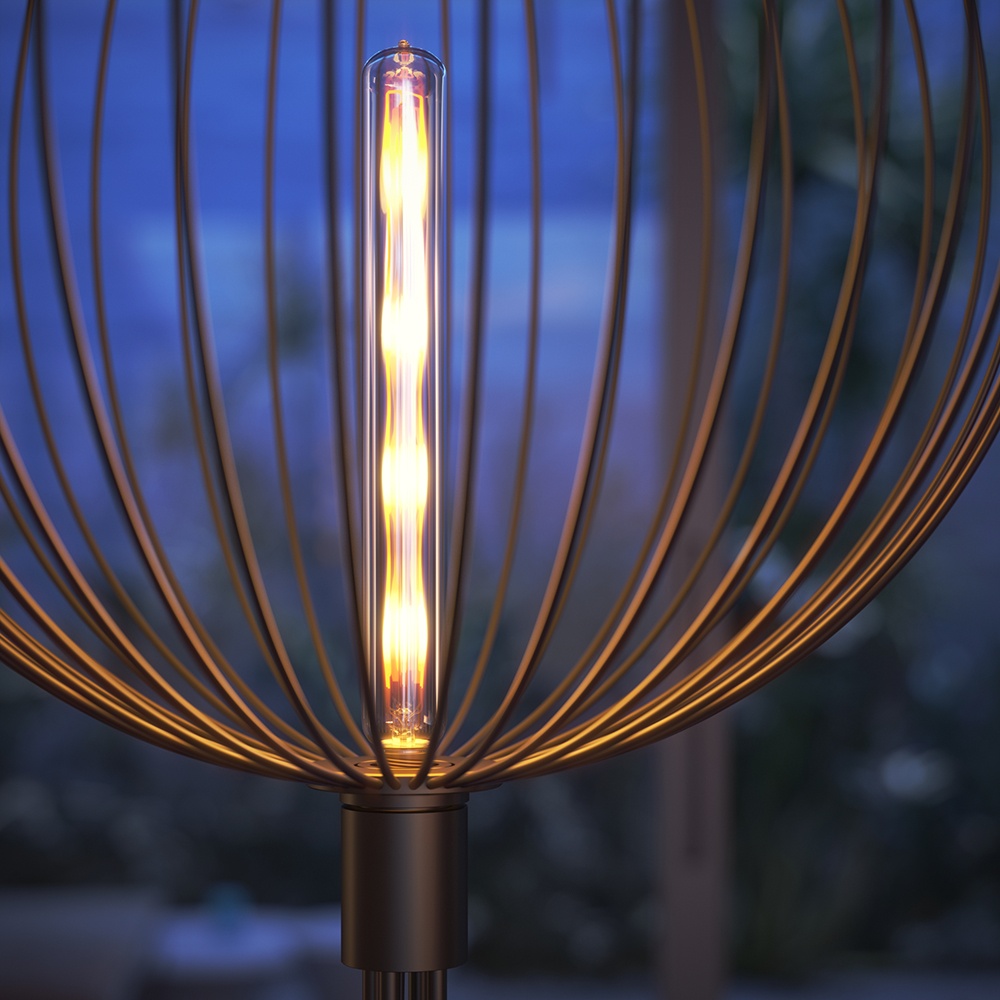This page provides some details on the settings available for the Light Material in V-Ray.
Overview
The V-Ray Light Material is a special material provided with the V-Ray renderer. This material is generally used for producing self-illuminated surfaces. Its light emission can be used for indirect and direct illumination in the scene, allowing for light sources of any shape. The Light Material may even be assigned at the object level and at the face level for self-illuminating only portions of a mesh.
A common use case of the Light Material is for illuminating light-emitting object(s) within a lamp, such as lightbulbs with wires, like in the example.
UI Paths
||V-Ray|| > Light Material
||Create|| > V-Ray > Light Material (disabled Separate menu for V-Ray materials)
Parameters
Light Color – This parameter controls the color of the light material. A Texture can also be applied and blended with the color, using the Mix Strength option.
Color Multiplier – A multiplier for the Light Color. A Texture can also be applied and blended with the value, using the Mix Strength option. Determine how the two are blended using the Mix Type option.
Opacity – A color to use as opacity for the material. Note that making the material less opaque does not affect the intensity of the self-illumination color. This is so that you can create perfectly transparent materials that nevertheless still emit light. A Texture can also be applied and blended with the color, using the Mix Strength option.
Emit on Back Side – When enabled, makes the object emit light from its back side as well. If this is off, the back side of the material is rendered as black.
Compensate Exposure – Used when rendering with the V-Ray Physical Camera. When enabled, the intensity of the material is adjusted to compensate for the camera exposure.
Multiply by Opacity – When enabled, the color of the light material is multiplied by the opacity texture. Otherwise, the color and opacity act independently (so-called additive transparency).
Outlines
Enable Outlines – When enabled, adds outlines to the object the material is applied to. This option is disabled by default.
Line Color – Determines the color of the outlines. A Texture can be applied.
Line Width – Determines the width of the outlines in pixels. The soft limit is 100. Click on the arrow to expand. A Texture can be applied.
Opacity – Determines how opaque the lines are. Click on the arrow to expand. You can attach a Texture for the opacity. The Mix Strength option determines the percentage of blending between the Opacity value and the texture.
Outer Overlap Threshold – Determines when outlines are created for overlapping parts of the object. Lower values reduce the outer overlapping lines, while higher values produce more overlapping outer lines.
Normal Threshold – Determines at what point lines are created for parts of the object with varying surface normals (for example, at the inside edges of a box). Lower values mean that only sharper normals generate an edge, while a value of 0.5 means that 90 degrees or larger angles generate internal lines. Higher values mean that smoother normals can also generate an edge. Don't set this value to pure 1.0, as this fills curved objects completely.
Overlap Threshold – Determines when outlines are created for overlapping parts of the object. Lower values reduce the internal overlapping lines, while higher values produce more overlapping lines. Don't set this value to pure 1.0, as this fills the objects completely.
Inner Line Control
Inner Line Control – When enabled, allows the inner line to be edited further. This option is disabled by default.
Inner Line Color – Determines the color of the inner lines. A Texture can be attached
Inner Line Width – Determines the width of the inner lines in pixels. Click on the arrow to expand for the Texture option, where you can attach a texture to serve as the inner line width.
Options
Material ID – The color used by the Material ID render element. You can also use a shader here.
Multimatte ID – The integer ID of the material to be used by the Multi Matte render element.
Round Edges Enabled – Enables the round edges effect, which uses bump mapping to smooth out the edges of the geometry during render time.
Radius – Specify a radius (in world units) for the round edges effect. Since the actual geometry is not being changed and only the normals of the faces are affected, large values here may produce undesirable effects.
Consider Same Object Only – When enabled, the rounded corners are produced only along edges that belong to the object, which has the attribute applied. When disabled, rounded corners are produced along edges formed when the object with the attribute intersects other objects in the scene.
Corners – Choose which edges are considered in the calculation. Possible options are:
Covex and Concave – Considers all edges.
Convex Only – Only applies Round Edges effect to edges with convex angles.
Concave Only – Only applies Round Edges effect to edges with concave angles.
Preview Settings
Override Preferences – When enabled, the parameters in this tab override the global preferences of the scene for the selected material.
Enable Preview – When disabled, the previews of the material in the Viewport and the Material Editor are disabled. The material is displayed in all black. This saves on processing power.
Enable Global Illumination – When disabled, global illumination is not calculated for the current material preview.
Quality – Determines the quality of the material previews. Higher values give more detail but slow down processing.
Editor Map Size – Determines the resolution of the material preview. If you have extra-detailed textures applied to the material, this option allows you to preview those textures in higher resolution at the preview step, without needing to render.
Default
64×64 (16 KB)
128x128 (64 KB)
256x256 (256 KB)
512x512 (1 MB)
1024x1024 (4 MB)
2048x2048 (16 MB)
4096x4096 (64 MB)








